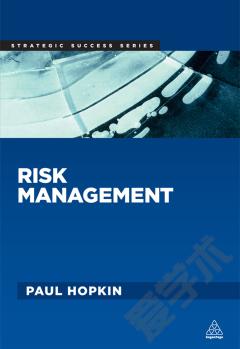Risk Management in Turbulent Times
INTRODUCTION I RISK MANAGEMENT: WHAT MUST BE CHANGED 1 Lessons From recent Financial Crises 1.1 The Basic Goals of Risk Management 1.2 When Risk Management Fails 1.3 What Should Be Done? 2 Living in Turbulent Times 2.1 New and Larger Risks 2.2 Increased Management Accountability 2.3 Need for a Global Approach 3 The Need for a Proper Methodology 3.1 The Necessary Ingredients 3.2 Risk Mapping 3.3 Loss Control 3.4 Risk Allocation II WHAT IS BEHIND RISK MODELING 4 The Basic Tools of Risk Modeling 4.1 Assessing Probabilities: The Frequentist and Subjective Approaches 4.2 Bayesian updating 4.3 Estimating Loss Distributions 4.4 Combining Event Trees and Monte Carlo Methods 4.5 The Dangers of the Stationarity Assumption 5 Statistical Risk Measures 5.1 The Expectation or Mean 5.2 The Variance 5.3 Linear Correlation 5.4 Copulas 5.5 The Value at Risk 5.6 Mutualization and Diversification 5.7 The Dangers of Using Simple Risk Measures Appendix: Extreme Value Theory 6 Leverage and Ruin Theory 6.1 Leverage and Return on Equity 6.2 Economic Capital for a Bank 6.3 Economic Capital for an Insurance Company 6.4 The Limits of Ruin Theory III THE PERFECT MARKETS HYPOTHESIS AND ITS DANGERS 7 Risk Neutral Valuation 7.1 The Expected Present Value Criterion 7.2 The Magic of Perfect Markets 7.3 Complete Markets and Absence of Arbitrage Opportunities 7.4 A Binomial Example 7.5 The Mirages of the Perfect Markets World 8 The Case of Incomplete Markets: Relating Risk Premiums to Economic Fundamentals 8.1 Solving the St Petersburg Paradox 8.2 Certainty Equivalent 8.3 Markets for Exchanging Risks 8.4 The Limits of the Equilibrium Approach 9 Risk Management in a Normal World 9.1 The Mean-Variance Criterion 9.2 Portfolio Choice 9.3 The Diversification Principle 9.4 Efficient Portfolios and the Sharpe Ratio 9.5 The Capital Asset Pricing Model (CAPM) 9.6 Futures Contracts and Hedging 9.7 Capital Allocation and RaRoc 9.8 The Dangers of Viewing the World as " Appendix 1: Portfolio Choice with Several Risky Assets Appendix 2: Deriving the CAPM Formula IV RISK MANAGEMENT AND SHAREHOLDER VALUE 10 Why Market Imperfections Matter for Shareholder Value 10.1 Standards Methods for Assessing Shareholder Value 10.2 Why is the Shareholder Value Function Likely to Be Non Linear: A Simple Example 10.3 Incentive Problems Generate Financial Frictions 11 The Shareholder Value Function 11.1 A Target Level of Cash 11.2 A Model for Optimizing Liquidity Management 11.3 Liquidity and Shareholder Value Appendix 1: Stochastic Differential Calculus Appendix 2: Derivation of the Shareholders Value Function 12 Risk Management and the Shareholder Value Function 12.1 How Much Risk to Take? 12.2 Which Risks to Insure? 12.3 How Much Liquidity to Keep in Reserves? 12.4 How Much hedging to Perform? V WHAT TO DO IN PRACTICE? 13 The Different Steps of the Implementation 13.1 Estimating the Shareholder Value Function 13.2 A Unifying Metric for Risk Mapping: The Risk Value Mapping 13.3 The New Instruments of Risk Management 14 Learning from an Example 14.1 Presentation of Med Corp 14.2 Risk Analysis 14.3 Shareholder Value and RM for Med Corp 14.4 A Risk Transfer Policy for Med Corp 15 Conclusion: Some Simple Messages 15.1 Message # 1: Quantitative models are needed but they have to be used with precaution 15.2 Message # 2: Risk Management creates value for shareholders 15.3 Message # 3: Things to do in practice 15.4 Message # 4: Key Ingredients for a successful RM approach Index
{{comment.content}}








 京公网安备 11010802027623号
京公网安备 11010802027623号